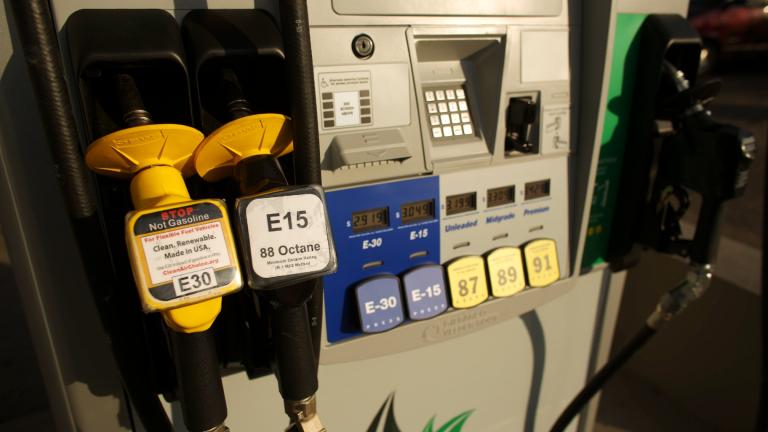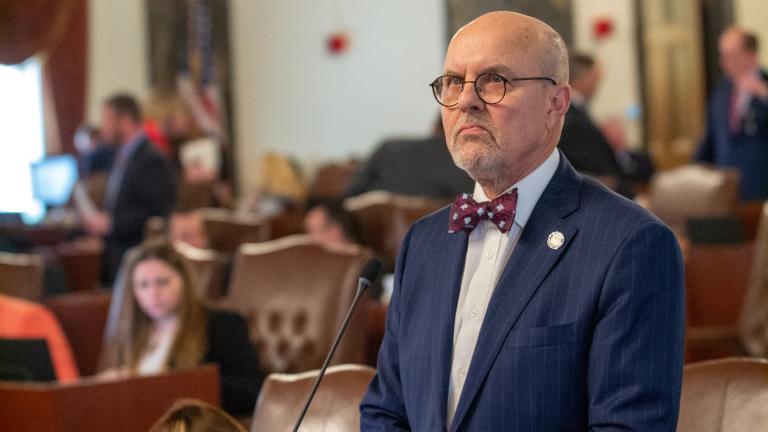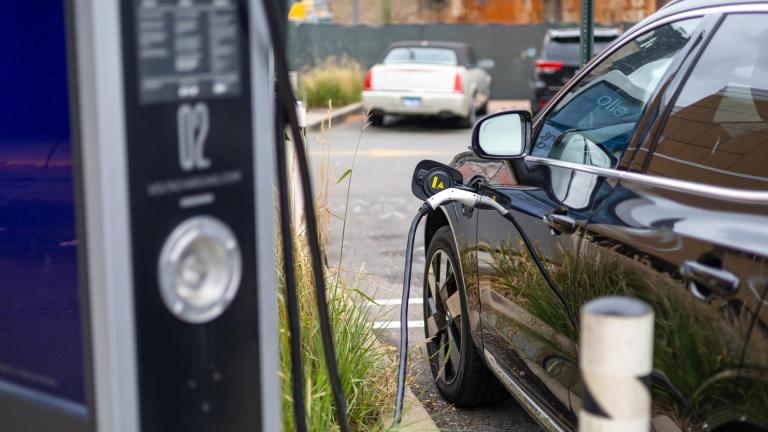 The Michigan City Generating Station has been burning coal for electricity for nearly a century. (WTTW News)
The Michigan City Generating Station has been burning coal for electricity for nearly a century. (WTTW News)
Environmental advocates in the Chicago area and northwest Indiana applauded a tough new slate of Environmental Protection Agency rules for coal-fired power plants — rules that cover local generating stations that are already offline or slated to be phased out.
The EPA came out with four new regulations Thursday, including a sweeping regulation to sharply limit greenhouse gas pollution at coal-burning plants. Those facilities must cut 90% of emissions by 2039 or shut down.
The regulations also take aim at mercury emissions, wastewater treatment and the coal ash byproduct amassed at current and former power plants across the country — including NRG’s offline generating station in Waukegan and NIPSCO’s slated-for-closure generating station in Michigan City. Both of those plants, situated alongside Lake Michigan, have been a flashpoint for environmental activists.
Coal ash, the byproduct created when plants burn coal for power, contains potentially dangerous materials like arsenic, mercury and cadmium. Some half a billion tons of coal ash remain at inactive facilities across the U.S., according to the environmental organization Earthjustice.
Advocates warn that the carcinogenic and neurotoxic material in the ash can seep into groundwater, and that many ponds and landfills may not be structurally sound — including lakefront sites that could endanger drinking water from the Great Lakes that millions rely upon. Coal ash is stored in ponds that may be lined or unlined, in landfills or piles, or mixed in with other materials to create infill.
Previous federal rules didn’t mandate the cleanup of sites that stopped receiving the byproduct before 2015. The EPA lists 13 unregulated, legacy coal ash sites across Illinois.
“The 2015 rule failed to regulate about half of the coal ash in existing leaking dumps, dumps that could be poisoning our water supplies,” Earthjustice senior attorney Lisa Evans said at a press briefing. “EPA’s rule picks up where the 2015 coal ash rule left off … (to) require monitoring and cleanup at an additional 700 coal ash dump sites.”
Evans said the EPA issuing new rules to prevent chemical leakage, clean up contaminated groundwater and require monitoring is a “watershed moment.”
“Utilities have fought coal ash regulation every step of the way with legislation, lawsuits and lobbying, deep pockets and friends in high places,” Evans said. “That ends today.”
“Neighborhoods of color and impoverished peoples have been disproportionately affected by coal ash pollution, causing cancers, asthma neurological disorders, heart and thyroid disease,” said Donita Scully of the La Porte County branch of the NAACP, one of the groups that sued the EPA to tighten its rules. “These communities must no longer bear the burden of these dangerous pollutants.”
Scully, who has lived and worked as a nurse for decades near the Michigan City facility, said she and her family have been purchasing purified water for 30 years because they feared coal ash contamination. Activists have documented what they say are the retaining walls keeping coal ash out of the lake in danger or failure, a claim the company owner disputes.
“I’m concerned about the people who don’t know about the threats to their health: the unsuspecting person who may eat contaminated fish from Trail Creek, the person who depends upon city water or the child who has asthma from breathing in coal ash,” Scully said.
While some of the deadlines for compliance were extended beyond what was proposed in draft rules, advocates still cheered the EPA’s move.
Just Transition Northwest Indiana, which has also been pushing NIPSCO to clean up the Michigan City power plant, applauded the new rules — noting that Indiana is home to more coal ash sites than any other state.
“We commend Administrator Regan and the EPA for making this historic stride toward environmental justice and holding polluters accountable,” JTNWI Executive Director Ashley Williams said in a statement. “The EPA must now act swiftly to enforce the complete cleanup and closure of all legacy coal ash dumps, including the Michigan City Generating Station, before it’s too late for our community and the millions of people who depend on Lake Michigan for drinking water.”
In a statement, the owner of the Michigan City generating station said it provides regular groundwater sampling and monitoring reports, that it has closed coal ash ponds at that site and is closing additional coal ash ponds at two other Indiana locations. However, activists have criticized the company for not removing coal ash in so-called “made land” or ash mixed with dirt or sand. The company also said it’s “on track to retire 100% of coal assets by 2028 and replace them primarily with renewables.”
“We all share in the outcomes related to the future of energy,” a company spokesperson said in a statement. “NiSource and NIPSCO are focused on ensuring the work it does satisfies its customers’ long-term energy needs in a way that balances the economic, social, and environmental interests of all its stakeholders. (The) company is reviewing the final EPA Legacy Coal Combustion Residuals (CCR) Surface Impoundment Rule to determine the compliance requirements for the company’s coal-fired generation facilities.”
A spokesperson for NRG, owner of the Waukegan site, said the company is “still in the process of evaluating the new regulations” regarding goal ash.
“We are proud of our environmental record and committed to delivering on our vision for a more sustainable energy future by targeting a 50% reduction of our greenhouse gases by 2025 (based on a 2014 base year) and net-zero emissions by 2050,” the statement said. “While we will evaluate the impact of these new rules on our operations, clear policy signals are essential to determining the path forward. To that end, NRG only supports policies that are authorized by the relevant statutes and encourage innovative, reliable solutions that are aligned with our vision for a smarter, cleaner, and more connected future.”
Environmentalists also cheered new guidelines mandating cleanup of toxic pollutants in the wastewater that generating stations release.
“Power plants for far too long have been able to get away with treating our waterways like an open sewer,” Earthjustice senior attorney Thom Cmar said. “It is long past time for this dangerous, damaging practice to end.”
The sweeping new rules will also force coal-fired plants to capture smokestack emissions or shut down.
New limits on greenhouse gas emissions from fossil fuel-fired electric plants are the Biden administration’s most ambitious effort yet to roll back planet-warming pollution from the power sector, the nation’s second-largest contributor to climate change. The rules are a key part of President Joe Biden’s pledge to eliminate carbon pollution from the electricity sector by 2035 and economy-wide by 2050.
The power plant rule marks the first time the federal government has restricted carbon dioxide emissions from existing coal-fired power plants. The rule also would force future electric plants fueled by coal or gas to control up to 90% of their carbon pollution. The new standards will avoid 1.38 billion metric tons of carbon pollution through 2047, equivalent to the annual emissions of 328 million gas cars, the EPA said, and will provide hundreds of billions of dollars in climate and health benefits, measured in fewer premature deaths, asthma cases and lost work or school days.
Coal plants that plan to stay open beyond 2039 would have to cut or capture 90% of their carbon dioxide emissions by 2032, the EPA said. Plants that expect to retire by 2039 would face a less stringent standard but still would have to capture some emissions. Coal plants that are set to retire by 2032 would not be subject to the new rules.
The plan is likely to be challenged by industry groups and Republican-leaning states. They have repeatedly accused the Democratic administration of overreach on environmental regulations.
Rich Nolan, president and CEO of the National Mining Association, said that through the latest rules, “the EPA is systematically dismantling the reliability of the U.S. electric grid.”
The Associated Press contributed to this report.
Contact Nick Blumberg: [email protected] | (773) 509-5434 | @ndblumberg








